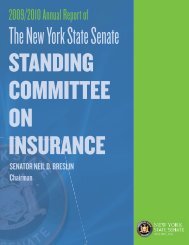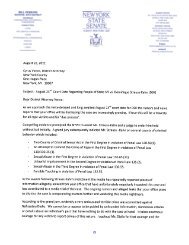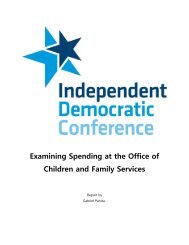Crime Committee Report e.indd - New York State Senate
Crime Committee Report e.indd - New York State Senate
Crime Committee Report e.indd - New York State Senate
Create successful ePaper yourself
Turn your PDF publications into a flip-book with our unique Google optimized e-Paper software.
crime, any recommendations by the judge and any statements by victims. By separating these<br />
provisions, it will clarify that the sentence and commitment documents are sent to the facility<br />
with the inmate, and that the sentence minutes must be sent later, helping to ensure that these<br />
critically important documents will become part of an inmate’s correctional file.<br />
S.5893 HASSELL-THOMPSON, THOMPSON<br />
Child Victims Act<br />
Section one of the bill amends the Criminal Procedure Law to increase the criminal statute<br />
of limitation for the prosecution of certain sex offenses committed against a child under the<br />
age of eighteen, for incest against a child less then eighteen years of age or the use of a child in<br />
a sexual performance. The period of limitation would not begin to run until the child reaches<br />
the age of 23 years or the offense is reported to a law enforcement agency or the statewide central<br />
register of child abuse and maltreatment.<br />
Section two of the bill would extend the civil statute of limitation for causes of action to<br />
remedy injuries or conditions suffered as a result of conduct which would constitute a sexual<br />
offense as defined in article one hundred thirty of the penal law committed against a child less<br />
than eighteen years of age, incest as defined in section 255.25, 255.26 or 255.27 of the penal<br />
law committed against a child less than eighteen years of age, or the use of a child in a sexual<br />
performance as defined in section 263.05 of the penal law. Such action would have to be commenced<br />
within five years after the child reaches the age of 23 years. Under current law, the<br />
criminal statute of limitations in child sexual abuse cases in which a victim does not report the<br />
crime to law enforcement is not applied until the victim reaches age 18. This bill would add<br />
five years to the statute; so that the five year statute of limitations in such cases would not begin<br />
to run until the victim turned age 23 (extending the time for prosecution until a child victim<br />
reached age 28).<br />
Section three of the bill would revive expired civil causes of action based on conduct which<br />
would constitute a sexual offense as defined in article one hundred thirty of the penal law committed<br />
against a child less than eighteen years of age, incest as defined in section 255.25, 255.26<br />
or 255.27 of the penal law committed against a child less than eighteen years of age, or the use<br />
of a child in a sexual performance as defined in section 263.05 of the penal law. Persons for<br />
whom the right to bring a civil action has been foreclosed because of the current civil statute<br />
of limitations bar would be given a one-year “window period” from the date of enactment of<br />
the bill. To recover damages for any past instance of child sexual abuse the civil claim must be<br />
commenced within thirty-five years of the effective date of this section or commenced within<br />
thirty-five years of such child reaching the age of eighteen years. Prior to the commencement<br />
of the action, the plaintiff must obtain a certificate of merit by a mental health expert that<br />
states in reasonable detail the facts and opinions relied upon for concluding that the plaintiff<br />
was a victim of sexual abuse. The complaint shall be accompanied by a certificate of merit as<br />
described in subdivision (c) of this section.<br />
Sexual assault is a crime that is devastating and life altering. The emotional confusion and aftermath<br />
experienced by a victim of a sexual assault can manifest a number of obstacles delaying<br />
or possibly eliminating the process of healing. When the victims of sexual assault are children<br />
the process of healing becomes their childhood. When a crime of this magnitude is committed<br />
against a child, someone who cannot defend or fight for themselves we must fight for them. If<br />
we allow the perpetrators of child sexual abuse to continue to prey on the children of <strong>New</strong> <strong>York</strong><br />
<strong>State</strong>, we are not only failing the children, but condoning the actions of these pedophiles. Due<br />
to the high number of unreported cases and the effect on the victim’s quality of life, it has become<br />
very apparent that the current laws of <strong>New</strong> <strong>York</strong> <strong>State</strong> pertaining to child sexual abuse are<br />
glaringly inadequate and unable to address the many legal and ethical issues that exist.<br />
The typical child sexual offender molests an average of 117 children, most of whom do not<br />
report the offense. Failure to report occurs often for a variety of different reasons. For example



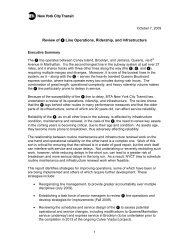



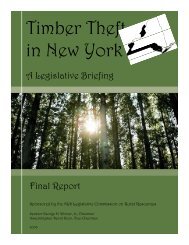

![[PDF] Proposed MTA Capital Program - New York State Senate](https://img.yumpu.com/24854139/1/190x245/pdf-proposed-mta-capital-program-new-york-state-senate.jpg?quality=85)



